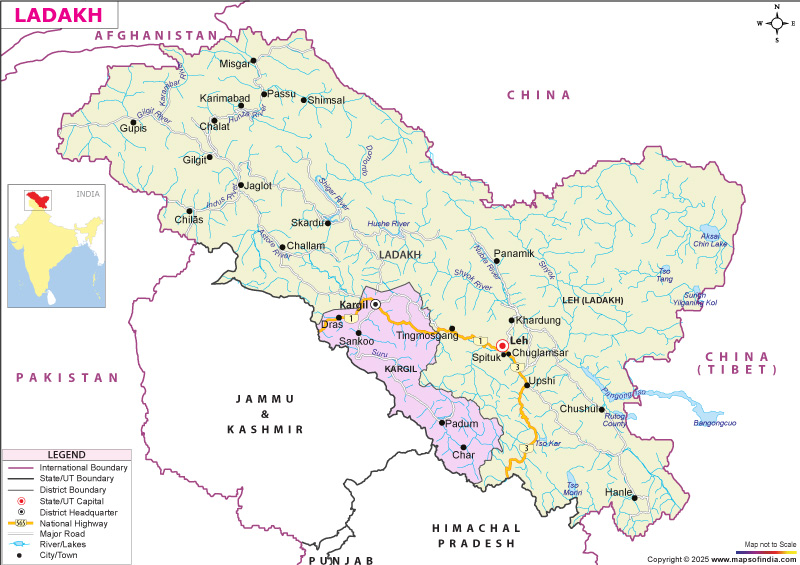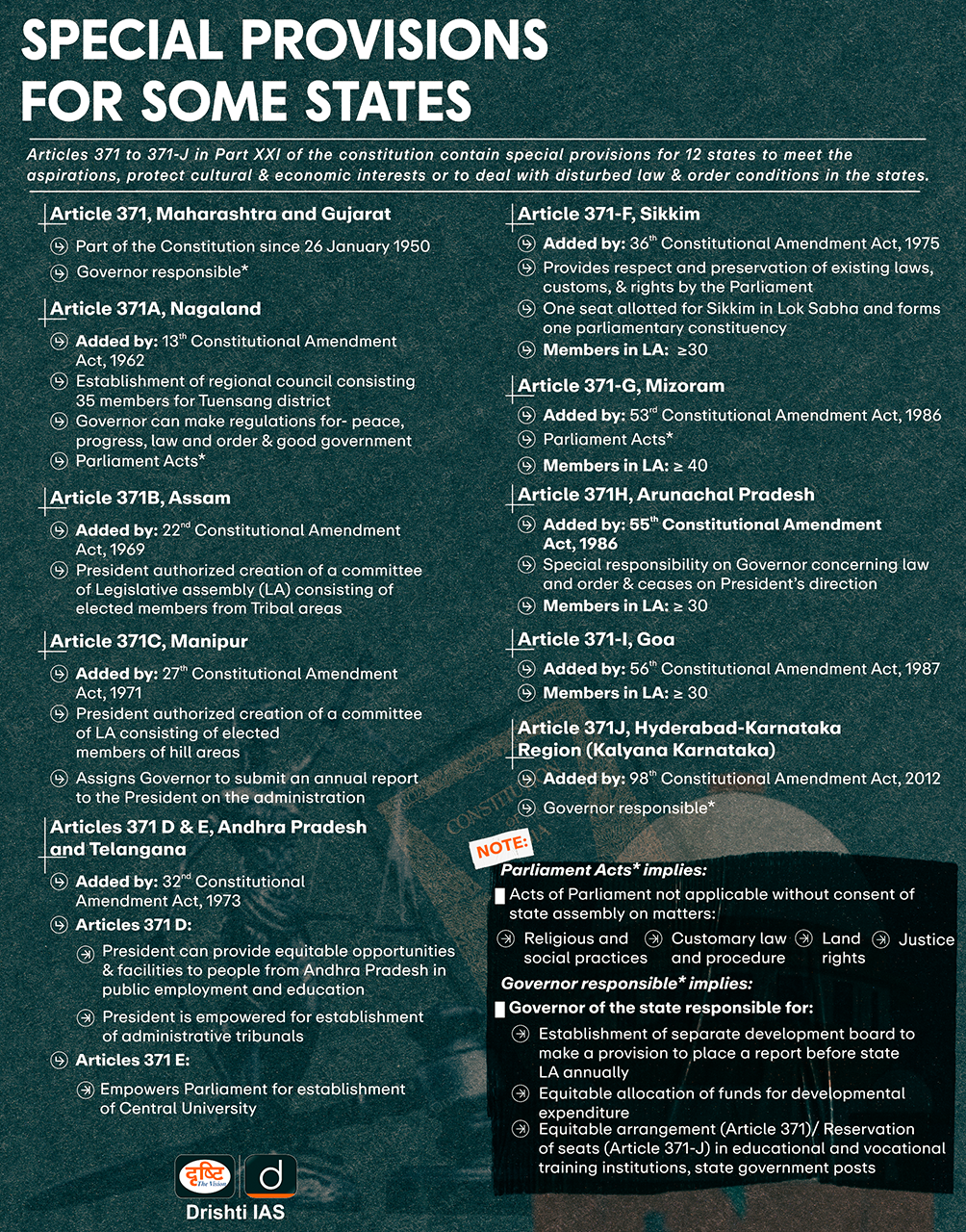Indian Polity
Regulation under Article 240 and Ladakh’s Demand for 6th Schedule
- 07 Jun 2025
- 12 min read
For Prelims: Article 240, Sixth Schedule, Article 370, Article 371, Autonomous District Councils, Articles 244(2), Governor, High Court.
For Mains: Overview of recent administrative measures for Ladakh and their shortcomings, key features of the Sixth Schedule, and further actions needed to improve Ladakh’s governance.
Why in News?
To address the long-standing demands for job reservations, language recognition, and political representation of Ladakh’s people, the Centre has issued few regulations for Ladakh under Article 240, rather than granting the Sixth Schedule status as was widely requested.
Note
- Article 240 empowers the President to make regulations for the peace and good governance of certain Union Territories, with these rules having the same force as Acts of Parliament and the power to amend or repeal existing laws.
What are the Demands of the People of Ladakh and the Regulations Notified by the Government?
- Key Demands: After the abrogation of Article 370 in August 2019 and the implementation of the Jammu and Kashmir Reorganisation Act, 2019, Ladakh was designated as a Union Territory without a legislature.
- In response, the Leh Apex Body (LAB) and the Kargil Democratic Alliance (KDA) have been advocating for Ladakh’s inclusion in the Sixth Schedule of the Constitution to safeguard their land, jobs, and cultural identity.
- Key Demands Included:
- Inclusion under the Sixth Schedule for constitutional protection.
- Land ownership restrictions to prevent outsider influx.
- Legislative Assembly for representative governance.
- As an alternative, the Union government proposed extending Article 371-like protections to the region.
- Key Regulations for Ladakh:
- Domicile Based Protection: For the first time, domicile-based job reservations for all government jobs has been introduced in Ladakh.
- The domicile criteria include 15 years of residency, 7 years of education and appearance in Class 10 or 12 from Ladakh among others.
- Provision for Reservations: Total reservations for SCs, STs, OBCs, and other socially and educationally backward groups in Ladakh are capped at 85%, while the 10% reservation for Economically Weaker Sections (EWS) remains intact.
- These provisions are also extended to professional colleges, enhancing local access to medical and engineering education.
- Preservation of Local Languages: The law designates English, Hindi, Urdu, Bhoti, and Purgi as official languages of Ladakh, while promoting Shina, Brokskat, Balti, and Ladakhi to preserve the region’s linguistic and cultural diversity.
- Representation for Women: Ladakh Autonomous Hill Development Councils LAHDC Act, 1997 has been amended to reserve one-third of the seats for women in the LAHDC of Leh and Kargil, through rotation.
- Domicile Based Protection: For the first time, domicile-based job reservations for all government jobs has been introduced in Ladakh.
Why are Ladakhis Demanding 6th Schedule Status of the Constitution?
- Constitutional Protection: Sixth Schedule status is being demanded because, unlike regulations issued under Article 240—which can be revoked or amended unilaterally by the Centre— the Sixth Schedule is constitutionally protected, ensuring greater autonomy and security for local governance.
- Safeguards for Land Rights: Sixth Schedule status is needed to restrict non-domiciles from buying land in Ladakh whose fragile ecosystem is threatened by unchecked tourism and infrastructure development.
- With over 97% tribal population dependent on land for their cultural and economic survival, protecting land rights is critical.
- Legislative Autonomy: Sixth Schedule status provides for Autonomous District Councils (ADCs) that can legislate on land, forests, water resources, customary laws, and education.
- LAHDCs remain administrative bodies dependent on the Centre for major decisions, limiting true self-governance.
- Symbolic Cultural Recognition: Sixth Schedule status is essential for preserving indigenous languages such as Bhoti, Purgi, and others, as it ensures education in local languages and the use of Ladakhi dialects in official communication.
- ADCs under the Sixth Schedule have constitutional authority over primary education and cultural preservation.
What is the Sixth Schedule of the Indian Constitution?
- About: The Sixth Schedule (Articles 244(2)) of the Constitution provides for the administration of tribal areas in the four northeastern states — Assam, Meghalaya, Tripura, and Mizoram — where tribes have largely preserved their traditional ways, unlike other tribal populations in India.
- Key Features:
- Autonomous Districts and Regions: Tribal areas are constituted as autonomous districts, which remain under the executive authority of the respective state.
- The Governor has the power to organize, reorganize, or redefine the boundaries of autonomous districts and divide them into autonomous regions if multiple tribes coexist.
- Autonomous District and Regional Councils: The Governor is empowered to create Autonomous District Councils (ADCs) and Autonomous Regional Councils (ARCs) in these four states.
- Each autonomous district has a district council of 30 members (26 elected by adult franchise and 4 nominated by the Governor), and currently, there are 10 such ADCs.
- Autonomous regions have their own regional councils.
- Councils hold office for 5 years unless dissolved earlier.
- Legislative Powers: Both ADCs and ARCs can make laws on matters like land, forests, water, shifting cultivation, village administration, marriage, inheritance, and social customs, subject to the Governor’s assent.
- Judicial Powers: Councils can constitute village councils or courts for tribal disputes and hear appeals.
- The High Court’s jurisdiction over these matters is defined by the Governor.
- Administrative Powers: Councils can manage primary schools, dispensaries, markets, roads, ferries, fisheries, and regulate money lending and trading by non-tribals with Governor’s approval.
- They can also assess and collect land revenue and impose certain taxes.
- Autonomy from State and Central Laws: Acts of Parliament or the state legislature may not apply or apply with modifications to these autonomous districts and regions.
- Governor’s Oversight: The Governor can appoint commissions to review administration and recommend dissolution of councils if necessary.
- Autonomous Districts and Regions: Tribal areas are constituted as autonomous districts, which remain under the executive authority of the respective state.
What Measures Can Address Ladakh’s Unique Needs?
- Constitutional Safeguards: If Sixth Schedule inclusion is not viable, a customized framework under 6th Schedule can be enacted by Parliament to safeguard Ladakh's demographic identity and empower elected bodies.
- Alternatively, the Sixth Schedule can be amended to include Ladakh-specific provisions, given its geopolitical and ecological sensitivity.
- Land Safeguards: Land ownership restrictions, similar to those in Jammu & Kashmir, Sikkim, or Himachal Pradesh, are essential to prevent outsider acquisition, safeguard traditional livelihoods, and protect Ladakh’s fragile ecosystem.
- A special Land Regulation Law should be enacted to limit land transfers to domiciled locals, with mandatory government approval for purchases by non-residents.
- Strengthening LAHDCs: LAHDCs should be granted legislative powers akin to ADCs under the Sixth Schedule, enabling them to enact laws on land, water, forests, education, and culture.
- Financial autonomy should be given to manage local resources such as tourism revenue and mining royalties, strengthening self-governance and regional development.
- Environmental and Tourism Regulation: Enforce ecotourism policies, carrying capacity limits, and environmental impact assessments, while promoting community-led conservation and restricting commercial construction in ecologically fragile zones.
Conclusion
The new Ladakh regulations under Article 240 address job reservations and language recognition but fall short of Sixth Schedule protections. Land rights and legislative autonomy remain unresolved. A customized constitutional safeguard, land ownership restrictions, and empowered LAHDCs are essential to balance development, tribal rights, and ecological sustainability in this strategic region.
|
Drishti Mains Question: Examine the significance of the Sixth Schedule of the Indian Constitution and evaluate its applicability to Ladakh in the context of recent demands and regulations. |
UPSC Civil Services Examination, Previous Year Questions (PYQs)
Prelims
Q. Which of the following provisions of the Constitution of India have a bearing on Education? (2012)
- Directive Principles of State Policy
- Rural and Urban Local Bodies
- Fifth Schedule
- Sixth Schedule
- Seventh Schedule
Select the correct answer using the codes given below:
(a) 1 and 2 only
(b) 3, 4 and 5 only
(c) 1, 2 and 5 only
(d) 1, 2, 3, 4 and 5
Ans: (d)
Q. Under which Schedule of the Constitution of India can the transfer of tribal land to private parties for mining be declared null and void? (2019)
(a) Third Schedule
(b) Fifth Schedule
(c) Ninth Schedule
(d) Twelfth Schedule
Ans: (b)
Q. The Government enacted the Panchayat Extension to Scheduled Areas (PESA) Act in 1996. Which one of the following is not identified as its objective? (2013)
(a) To provide self-governance
(b) To recognize traditional rights
(c) To create autonomous regions in tribal areas
(d) To free tribal people from exploitation
Ans: (c)
Mains
Q. Why are the tribals in India referred to as ‘the Scheduled Tribes? Indicate the major provisions enshrined in the Constitution of India for their upliftment. (2016)








